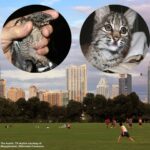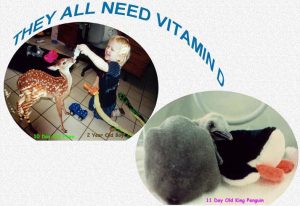What Is vitamin D, And Why Do All Animals And People Need It?
Ron Hines DVM PhD
 Read About Vitamin D Overdose In Pets
Read About Vitamin D Overdose In Pets
 Wildlife Rehabilitation Guidelines
Wildlife Rehabilitation Guidelines
Vitamin D = (Cholecalciferol) Humans do fine when they receive enough vitamin D2 in their diet. Our pets do fine when they receive enough vitamin D3 in their diets.
How Much Vitamin D3 Should My Pet Receive?
Adding vitamin D to the diets of pets is always risky when those commercial diets already contain correct amounts of Vitamin D. This is because too much vitamin D is as bad or worse than not enough.
Vitamin D (also known as cholecalciferol in it’s D3 form) is required for the intestines to absorb calcium to regulate important blood calcium levels and to produce and remodel bone. People, cows, horses, and pigs and people can synthesize their own vitamin D from dietary lipids of animal or plant origin, if their skin is exposed to natural sunlight. Too little vitamin D, the wrong kind of it, not enough natural sunlight, inadequate calcium or inappropriate calcium to phosphorus ratio in the diet cause a disease called rickets. Dogs and cats cannot synthesize vitamin D-3; in the wild they would obtain it by eating prey so it is added to all their complete commercial pet foods.
Parrot-like birds appear to do well with about 600 iu of vitamin D3 per pound of dry pelleted diet fed – slightly higher , with increased calcium when they are laying eggs. In the bird species studied, none were able to utilize vitamin D2. I seem to recall that the human recommended daily allowance of vitamin D is about 400iu**. To the best of my knowledge, all commercial pelleted avian diets contain added vitamin D3 in similar amounts. It is a fat-soluble vitamin, so it persists in the body and can not be added to the bird’s water effectively. Signs of too little or a bit too much vitamin D can take considerable time to show themselves because it is stored for long periods in the body’s fat. As I said previously, birds seem to only absorb vitamin D3 whereas people can absorb or synthesize vitamin D2 & D3.
Vitamin D is added to milk, marketed in the United States, as irradiated ergosterol. The problem with vitamin D is that in high doses it can be very toxic. It can cause hypercalcemia (too much calcium in the blood) which affects the heart, other organs and will cause liver toxicosis. In fact, some rat baits are just vitamin D analogues although most are Warfarin-based anti-clotting agents. It causes me fits in iguanas where it is involved in metastatic (wrong place) calcification of the kidneys. Overdoses can do this to birds as well.
At 3-5 times the required amount, vitamin D3 can cause calcification of the kidneys and stomach (proventriculus) of birds and gout in mature birds – probably due to kidney damage. You can get that high if you feed your birds a lot of egg yolk, or certain fish oil supplements in addition to their regular diet. Vitamin D/Calcium/sunlight problems cause me fits in iguanas when it causes calcification of the kidneys. In birds of prey, therapy has been suggested at 1,000iu/300gm/wk. Macaw and parrot chicks seem most susceptible to D3 overdose which at four time the recommended dose causes calcification of the kidneys and stomach and in mature birds leads to gout through kidney damage. So don’t go overboard with vitamin supplements – feed a name-brand, complete pelleted diet instead! Many are available through our web page. I have read scientific articles that claim that cruciferous vegetables – cauliflower and broccoli contain oxalic acid, which combines with dietary calcium as insoluble calcium oxalates. Macaws and parrots can synthesize their own vitamin D3 if they receive plant lipids in their diet and natural sunshine. So it’s all very complicated and poorly understood because so many things are interacting – I have only mentioned a few.
**iu = international units


 Dear reader, Besides your donations, Visiting the products that Google chooses to display on this webpage helps me pay the cost of keeping this article on the Web. As you know, sites like mine that are not designed to make money are getting harder and harder to find. Best wishes, Ron Hines
Dear reader, Besides your donations, Visiting the products that Google chooses to display on this webpage helps me pay the cost of keeping this article on the Web. As you know, sites like mine that are not designed to make money are getting harder and harder to find. Best wishes, Ron Hines